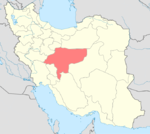Kashan
| Kashan کاشان |
|
|---|---|
| — City — | |
 |
|
 Kashan
|
|
| Coordinates: | |
| Country | |
| Province | Isfahan Province |
| Time zone | IRST (UTC+3:30) |
| - Summer (DST) | IRDT (UTC+4:30) |
| Website | Kashan.ir |
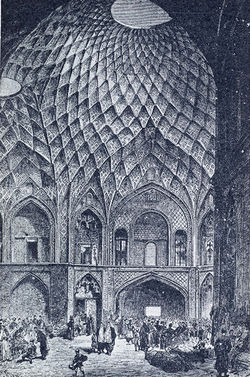

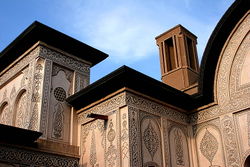
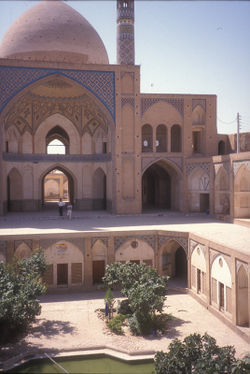
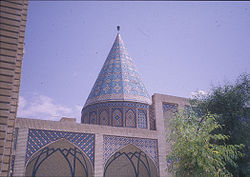

Kashan (Persian: کاشان, Kāshān) is a city in the province of Isfahan, Iran. It had an estimated population of 272,359 in 2005.[1]
The etymology of the city name comes from Kasian, the original inhabitants of the city, whose remains are found at Tapeh Sialk dating back 9,000 years; later this changed to Kashian, whence the town name. The Persian word Kashi, which translates into the English word "tile". Kashan is the first of the large oases along the Qom-Kerman road which runs along the edge of the central deserts of Iran. Its charm is thus mainly due to the contrast between the parched immensities of the deserts and the greenery of the well-tended oasis.
Contents |
History
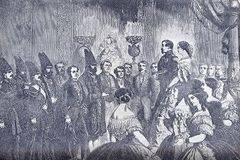
Archeological discoveries in the Sialk Hillocks which lie 4 km west of Kashan reveal that this region was one of the primary centers of civilization in pre-historic ages. Hence Kashan dates back to the Elamite period of Iran. The Sialk ziggurat still stands today in the suburbs of Kashan after 7000 years.
The artifacts uncovered at Sialk reside in the Louvre in Paris and the New York Metropolitan Museum of Art, and Iran's National Museum.
By some accounts - though not all - Kashan was the origin of the three wise men who followed the star that guided them to Bethlehem to witness the nativity of Jesus, as recounted in the Bible. Whatever the historical validity of this story, the attribution of Kashan as their original home testifies to the city prestige at the time the story was set down.
Abu-Lu'lu'ah/Pirouz Nahāvandi, the Persian soldier who was enslaved by the Islamic conquerors and eventually assassinated the caliph Umar al-Khattab in 23 AH (644–645) CE, reportedly fled to Kashan after the assassination and lived there some years before being finally caught and executed. His tomb is one of Kashan's conspicuous landmarks (see gallery below).
Sultan Malik Shah I of the Seljukid dynasty ordered the building of a fortress in the middle of Kashan in the 11th century. The fortress walls, called Ghal'eh Jalali still stand today in central Kashan.
Kashan was also a leisure vacation spot for Safavi Kings. Bagh-e Fin (Fin Garden), specifically, is one of the most famous gardens of Iran. This beautiful garden with its pool and orchards was designed for Shah Abbas I as a classical Persian vision of paradise. The original Safavid buildings have been substantially replaced and rebuilt by the Qajar dynasty although the layout of trees and marble basins is close to the original. The garden itself however, was first founded 7000 years ago alongside the Cheshmeh-ye-Soleiman. The garden is also notorious as the sight of the murder of Mirza Taghi Khan known as Amir Kabir, chancellor of Nasser-al-Din Shah, Iran's King in 1852.
The earthquake of 1778 leveled the city of Kashan and all the edifices of Shah Abbas Safavi, leaving 8000 casualties. But the city started afresh and has today become a focal tourist attraction via the numerous large houses from the 18th and 19th centuries, illustrating the finest examples of Qajari aesthetics.
Today
Although there are many sites in Kashan of potential interest to tourists, the city remains largely undeveloped in this sector, with fewer than a thousand foreign tourists per year. Qamsar and Abyaneh are notable towns around Kashan, which attract tourists year around. The nearby town of Niasar features a man-made cave and fireplace of historical interest.
Kashan is internationally famous for manufacturing carpets, silk and other textiles. Kashan today houses most of Iran's mechanized carpet-weaving factories, and has an active marble and copper mining industry. Kashan and suburbs have a population of 400,000.
Main sights
Kashan's architectural sights include:
- Agha Bozorg Mosque.
- Boroujerdi ha Residence.
- Tabatabaie Residence
- Ameri-Ha (Amerian) House
- Abbasian House
- Sharifian House
- Al-e-Yaseen House
- Sultan Amir shrine and bath
- 40 Dokhtaran Fortress
- Pirouz Nahavandi/Abu-Lu'lu'ah Shrine (the assassin of Islam's second Caliph)
- Fin Garden
- Sialk ziggurat
- Ghal'eh jalali
- Kashan Bazaar
- Timcheh Amin-o-dowleh
Education
Colleges and universities in Kashan include:
- Kashan University of Medical Sciences
- Islamic Azad University of Kashan
- University of Kashan
Roads
- Road 71
- Freeway 7, located near the city
Kashan is connected via freeways to Isfahan and Natanz to the South, and Qom, which is an hour drive away to the north.
Famous Kashanis
- Sohrab Sepehri
- Ghyath ad-Din Jamshid Kashani
- Kamal-ol-Molk
- Akram Pedramnia
- Mohammad-Nabi Sarbolouki
- Ustad Ali Maryam
- Muhsen Feyz Kashani
- Mohammad Alavi (footballer)
- Javad Kazemian(Footballer)
- Ehsan Hajysafi(Footballer)
- Mostafa Chatrabgoon (Footballer)
- Hosein-Shirazi
- Seddighi
- Yedidia Shofet the former chief rabbi of Iran and the worldwide spiritual leader of Persian Jewry.
- Leghāi-e Kāshāni, poet
- Amir Ghiāss od-Din, one of the Generals of the Safavid King Shah Abbas II who accompanied Shah Abbas in the wars leading to the conquest of Kandahar in 1648. He is the patriarch of the Zarrābi family in Kashan and one of the ancestors of the renowned Iranian poet Mohammad-Taqí Bahār.
- Isaac Larianis the Chief Executive Officer of MGA Entertainment, the biggest privately owned toy company in the world.
- David Alliance, Baron Alliance Businessman and a Liberal Democrat politician in the United Kingdom.
Famous families
- Borujerdi
- Tabatabaei
- Nezam Kashani
- Esfahanian
- Ghaffāri
- Sharifian
- Zarrābi
- Mohagheghi Baadi
Sister cities
See also
- Kashan rug
- Iranian Architecture
- Sialk - Kashan's ancient architecture.
- Traditional Persian residential architecture
References
External links
- About Kashan
- "Humble Earth": Kashani residential architecture (if link does not work, refresh)
- Photos from Kashan
- Shapour Bahrami, Kashan, Iran, Photo Set, flickr.
- The Ghaffari Clan of Kashan.
- Great information and pictures of Kashan.
- Kashan Carpets and Rugs
- Hamid-Reza Hosseini, Kashan's Houses (Kāshāneh-hā-ye Kāshān), in Persian, Jadid Online, 24 February 2009, [1].
Audio slideshows, Jadid Online: (1) (5 min 43 sec), (2) (1 min 36 sec). - Hamid-Reza Hosseini, Earthbound Paradises (Behesht-hā-ye Zamini), in Persian, Jadid Online, 25 February 2009, [2].
Audio slideshow, Jadid Online, [3] (6 min).
|
||||||||||||||||
|
||||||||||||||||

